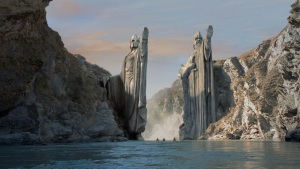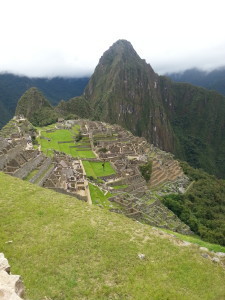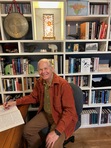Stephen Weinstock's Blog, page 5
August 12, 2015
World Elephant Day 2015 tale
Elephants are the official karmic mascot of 1001, The Reincarnation Chronicles. In honor of World Elephant Day, re-visit this story of one of the noble critters from the series.
And for a free book giveaway, join 1001/Qaraqbooks News, my free email subscription. Find out when Book 2, The Qaraq and the Maya Factor is coming out (s00n).
August 10, 2015
25 New Beatle Albums! Part 2
One of the most popular posts on my website was about the trend of creating fantasy albums by The Beatles. Fantasy because the albums come from after their break-up, using the best songs from their solo albums in any given year. I’ve been gratified that the post was so popular, even if the site is less about music and more about my work as the author of the 1001, The Reincarnation Chronicles series, including The Qaraq and The Qaraq and the Maya Factor, due out soon.
Given the great response to the post-Beatles article, which you can revisit here, many people have asked me for more of the playlists. There’s a lot of them, so I’ve posted the first of two installments on 1001/Qaraqbooks News, my free email subscription service. There you’ll find the albums from the 70s, before us boomers strayed from listening to the solo efforts, and the 80s, when I tried to keep John’s material represented after his death. George doubles his contribution from the time of the Beatles, especially with all the great songs from All Things Must Pass and Living in the Material World.
Here’s a sample from 1971:
Post-Beatles 1971 SIDE A
1 Imagine 3:05 John Lennon
2 Uncle Albert/Admiral Halsey 4:55 Paul McCartney
3 Wah-Wah 5:39 George Harrison
4 Long Haired Lady 6:07 Paul McCartney
5 Oh Yoko! 4:22 John Lennon
6 Isn’t It A Pity 7:12 George Harrison
SIDE B
1 Smile Away 3:57 Paul McCartney
2 Apple Scruffs 3:09 George Harrison
3 How Do You Sleep? 5:39 John Lennon
4 Every Night 2:31 Paul McCartney
5 It Don’t Come Easy 3:02 Ringo Starr
6 Isolation 2:55 John Lennon
7 Back Seat Of My Car 4:33 Paul McCartney
8 Happy Xmas 3:36 John Lennon
There are at least three mega-hits here, plus a few charmers, and a soul-stirrer or two. There’s the oddity of including “How Do You Sleep?,” John’s cruel bash of Paul, if in the fantasy the band hadn’t broken up. But it contrasts “Apple Scruffs” so well, and casts an ironic pall on Paul’s “Every Night.” Anyway, that’s the fun of doing this, ordering the songs as a playlist, and balancing the whole.
If you don’t know a song, sample it on iTunes. If you’re curious about my thought process behind the playlists, ask me, or refer to the original article. And if you want to see all the playlists, sign up for 1001/Qaraqbooks News.
Most importantly, if you’re wondering when Book Two of 1001, The Reincarnation Chronicles is coming out, be the first to hear about it. If you haven’t read Book One, find out when I’m giving it away for free. In the next two months there will be giveaways of Book One and Two, and a celebration of the launch of The Qaraq and the Maya Factor. So sign up for free here.
July 28, 2015
1001, The Reincarnation Chronicles, and Magic Realism
One Valentine’s Day, my wife gave me a sadistic gift. She signed me up for Pitchapalooza, a book marketing workshop given by The Book Doctors at our local library. I had to get up and pitch my novel to a panel of writers, agents, and publishers. Terrifying. And then they critiqued my pitch. More terrifying.
But fascinating. In my series, 1001, The Reincarnation Chronicles, a group of linked souls, a qaraq, remember 1001 of their lifetimes together. In each chapter someone recalls and recounts a new past life tale, ranging from historical fiction to sci-fi to romance to whatever. I had no clue how to define the genre, my audience, or, sadly, my pitch. But Liza Dawson, an agent, said to me, “Your book’s genre sounds like Magic Realism to me.”
Now, I know my Borges and love Gabriel Garcia Marquez, so I was familiar with a school of Latin America writers who established the term Magic Realism. But through my terrified shock I thought, “Magic Realism is a genre? You’re allowed to do that? I’m allowed to call my genre that? Really?” It was a defining moment for my understanding of the modern book business, because I realized there was more out there than Mystery and Fantasy. There were now sub-genres and hybrid genres and invented genres. If Magic Realism was a marketing genre, as well as a modern creation of genius, then I could call fantastical books about reincarnation Karma Lit.
I’m so happy to be part of Zoe Brooks’ Magic Realism blog hop because it gives me a chance to investigate my series and its relation to Magic Realism. My immediate question is: what’s Magic and what’s Realism in my book? The present day characters who recall their past lives are neighbors in suburban New Jersey. They have jobs, family issues, and commutes. That’s Realism. Then they can have a memory of a lifetime as an atomic particle. That’s Magic.
Or: although commonplace suburbanites, the qaraq has the power to recall past lives. That’s Magic! But in the worlds they remember, there are protocols, daily dramas, and human emotions, even if as an anthropomorphized Carboniferous Era dragonfly arguing with itself about food vs. sex. That’s Realism! However you slice it, it’s Magic Realism.
Here’s another way to think about how the fantastical and the real rub elbows in 1001, The Reincarnation Chronicles. The interaction occurs all by itself in the present day, and all by itself in the past life stories. In suburbia, the realistic details of everyday life can trigger a magical entry into a new world. Shopping in the frozen food section of the supermarket sends a member of the qaraq back to an Ice Age lifetime, where her tribe deals with glaciation by denying Winter and re-scheduling the calendar into three seasons. In the second book of the series, The Qaraq and the Maya Factor — soon to come out — the banal pressures of suburban life threaten the qaraq’s super-powered memories. Realism VS. Magic.
In the Arabian Nights-inspired tales, Magic confronts Realism. A laundromat in a parallel universe, complete with pyramid-shaped washers, influences the workings of the ancient Egyptian pantheon of Gods. In an alien performing arts school, dancers exercise their nerves as well as muscles, enabling them to leap from lying down to mid-air in a microsecond. But the school still tends with budget cuts, neurotic students, and prima donna faculty. Or, a bureaucratic Heaven requires religion profile forms in triplicate.
Ultimately, Magic Realism helps me achieve the mission of 1001, The Reincarnation Chronicles, and that mission helps me achieve one of the principles of Magic Realism. Most books about immortality sustain a mystery driving the plot where everything leads to a revelation of the secret to everlasting life, say the Sorcerer’s Stone. In my series it is assumed from the get-go that we are immortal, and the question is: “How do we deal with having lifetime after lifetime?” What’s the realistic consequences of this magical phenomenon, physically, emotionally, and spiritually?
I believe that Magic Realism enables us to be convinced of the realistic possibility of a magical phenomenon, at the same time enabling us to find magical properties in everyday life. 1001, The Reincarnation Chronicles continues this Magic Realism tradition. Even if at first I didn’t know I could call it that.
Catch up on Book One, The Qaraq here.
Find out when Book Two, The Qaraq and the Maya Factor, will be released here, along with news and special offers.
Check out the Magic Realism Blog Hop!
This post is part of the Magic Realism Blog Hop. About twenty blogs are taking part in the hop. Over three days (29th – 31st July 2015) these blogs will be posting about magic realism. Please take the time to click on the button below to visit them and remember that links to the new posts will be added over the three days, so do come back to read more.
April 15, 2015
Picchu Keanu!
Just returned from a dazzling trip to Peru, Lake Titicaca, and Macchu Picchu. Here’s a few excerpts from my travel journal, followed by a sweet offer:
“After years of waiting, I finally visit Macchu Picchu, the Old Mountain. First of all, the train and bus ride to the summit alone are worth the trip. The round-top peaks lining the sacred Inca valley, the spring greens, and the mists are so beautiful that an ancient ruin isn’t necessary.”
“Our guide is native Quechuan, and is the mellowest human being I have ever met. But he speaks about the place, not with the ambiguous uncertainty of the theorists, who are unsure if Macchu Picchu was a shrine, a trading center, or a noble’s country home, but with a pride and surety that the city was all of these things and more. It feels like he is a descendant of the people living here centuries ago.”
“I had never imagined the ruin to be so intact, so comprehensive, and so huge. The only thing missing seems to be the thatch on the roofs, and the objects inside rooms, which now lie in museums.”
“The city is so well preserved because of the Inca stonework. Every stone fits perfectly with the others, and since they did not use mortar, during earthquakes the stones bobble around then fall back into place. Spanish walls at the same times crack or fall apart.”
“Tourists are not allowed to walk on the huge open green central square of the city. But llamas freely graze there, earning their food as the urban greenskeepers, camelid lawnmowers. I do not learn the difference between a llama, alpaca, and vicuna on this trip, but I do enjoy an alpaca hamburger.”
“In the Floating Islands of the Uros people in Lake Titicaca, everything is made of reeds, including their homes, the ground they stand on in these man-made islands, and the food they eat. A truly remote place, with its unique way of choosing to live.”
That’s a taste of my wonderful journey. If you subscribe to 1001/Qaraqbooks News, in a week I will post a new story from 1001, The Reincarnation Chronicles, inspired and set in Macchu Picchu.
March 31, 2015
Scheherazade.2
I was excited to attend the premiere of John Adams’ ‘dramatic symphony’ at the New York Philharmonic. Scheherazade.2 at the very least proves that the tremendously evocative female character of Medieval Arabic literature still resonates, inspires, and empowers artists to create great works. Since the main character of my 1001 series is a modern day Scheherazade, I was curious what John Adams would do with his modern version.
Taking off from Rimsky’s tone poem with minimal blurbs for each musical movement, we get the depiction of a modern woman of great power and bravery, brutally oppressed by the fundamentalist male world. Scheherazade is portrayed by a violin soloist, passionately performed by Leila Josefowicz, often accompanied by the Hungarian table dulcimer, the cimbalom, an instrument championed by Stravinsky during World War I.
The cruel world is depicted by the orchestra, and this is not the ostinato-machine orchestra of Nixon in China or even the later Dr. Atomic, but a dissonant, dense, post-serial orchestra that is clearly the work of John Adams in his ‘late period.’ Not since Orlando di Lassus was struck by lightning and totally cleaned up his harmonic language, or Stravinsky threw off neo-classicism for his rival Schoenberg’s harmonic vocabulary has a composer made such a transformation. All to serve the drama.
I am waiting to make any further judgments until I hear a recording, since this is such a dense, complex work. But I have read a lot of reviews, and found the Wall Street Journal’s article the smartest of the lot. Here it is, with mention of other recent premieres by major composers.
For more exclusive articles and free offers, subscribe to 1001/Qaraqbooks News:
March 11, 2015
When Ursula Dissed Kazuo: 8 Bits of Book Gossip
The novel is always changing. Has always, will always. But here’s 8 links to posts about current stuff going on that points to a radical departure from lit as we know it.
1) Kazuo Ishiguro’s new book, The Buried Giant, sparked a debate about the breakdown of genre literature, and the consequences of blurring or obliterating genre lines. In this interview in the NY Times, Ishiguro hoped readers would understand his intentions for having ogres and dragons in his book, and not chalk it up to fantasy.
2) This attitude pissed off the classic fantasy author Ursula LeGuin, who wrote a review in which she accused Kazuo of degrading fantasy, whether he wanted to call his book fantasy or not.
3) In classic author mode, Kazuo wrote this rebuff of Ursula’s attack, denying any snobbery against fantasy on his part.
4) Being an author who likes to mix and mutate fantasy and other genres, I never anticipated this genre play might insult a traditional genre writer. But I suppose it’s all a matter of one’s attitude, mine coming from a place of love and influence. For a nice perspective on the whole mess, here’s a detailed parse of the debate in flavorwire.
5) In an ironic punchline, a few days later, George R.R. Martin received an accolade, in thanks donated a first edition of The Hobbit to a university, and in his acceptance speech, celebrated that fantasy was finally getting its literary due. Maybe yes, maybe no.
6) Meanwhile, on the other side of the book world, in literary fiction, novelists are saying they are bored and embarrassed by fiction, as evident in this New Yorker article about the new book by Rachel Cusk. Finding a falseness in making things up, there is a new trend to blend heavy doses of autobiographical material into the novel.
7) One way of looking at this trend is as a reinvention of the diary, as discussed in this review of an old favorite author of mine, Zadie Smith, who I thought made up stuff just fine. But she’s mixing her life into her fiction the way Picasso mixed newspaper clippings into his Paris canvases.
8) So to finish, how about a sweet name for this new trend? Try this article about Autofiction, which discusses Karl Ove Knausgaard’s seven volume series that tracks his mid-life crisis.
It seems there must be a connection between the crumbling of and sensitivity to genre fiction, and the wholesale rejection of fiction. We’re just not feeling satisfied with what we’ve got in hand anymore. I for one have been suffering deeply with this dilemma lately. But you’ll have to subscribe to my email list to get a firsthand account, in my latest confession to loyal fans.
March 1, 2015
A Movable Golden Age
My task this year is working on several books at once in the 1001 series, and with that comes the pleasure of tracking an idea like The Movable Golden Age. As I humbly learn how to entice readers to discover The Qaraq, Book One of The Reincarnation Chronicles, I wait for my editor Debra Ginsberg to do her magic on Book Two, and so forge ahead drafting Book Four (over half done!). What about Book Three, you ask? Don’t ask.
What’s a Movable Golden Age? Consider what a Golden Age is first. I think of them as short-lived, maybe part of a longer arc like an Empire, with its Rise and Fall, but the Golden Age heyday is just the cherry at the top of the Rise.
For example:
Classical English drama may have been excellent for centuries, but Shakespeare hit his peak over about thirty years.
Rock & Roll may be here to stay, but The Beatles accomplished their revolution in less than a decade.
We may be in a new Golden Age of television, with excellent acting, writing, and long arc series, but I think we’re coming off the hump. If this Golden Age coalesced with The Wire and Lost and The Sopranos over ten years ago, those long arcs and cliffhangers have become more formulaic in the last few years, IMHO. Another decade long Golden Age, which will nonetheless continue to inspire a while longer.
So in Book One of the 1001 series, an idea is introduced that at any given time on the planet, and/or the universe, there is a Golden Age bubbling up somewhere, which will shortly give way to a new one. On another continent, in another language, on the breeze of an Escape Wind.
In Book Two we learn of the Xoo, an inter-galactic prison for radical thinkers, one of whom posits the Movable Golden Age theory, among others. And in Book Four, I’m currently writing a 32-chapter frame tale during the Age of Exploration, where we witness the Chinese and European ‘discovery’ of America, global expansions and diasporas, and of course, Movable Golden Ages.
What about Book Three? Don’t ask.
It’s a fascinating historical subject to analyze why civilizations come and go, empires rise and fall, and Golden Ages pop up when the perfect set of ingredients come together for a glorious recipe. But just as the cooking process takes much longer than the enjoyment time of a good meal, the Golden Age has that bittersweet short-lived half-life. Too much of a good thing….
So that’s a little taste of the process I’m lost in, and the ideas that 1001 entertains. Some day I’ll let you know why Book Three was such a bear to write. For now, that’s right, don’t ask.
If you like what you’re reading, please subscribe to 1001/Qaraqbooks News, a monthly email service with book news, free offers, and blog exclusives.
February 20, 2015
A Winter’s Tale of Denial
Not to complain, but a friend of mine just landed in Anchorage, Alaska, and wrote that it was warmer there than here in New York City. The wind chill is minus 25! My car temperature says One! When I open the door to let them out, my cats look at me like I’m nuts! Brrrnik!
Some comforting thoughts, fellow frozen friends. Spring is one month away. It’s been real sunny most of these frigid days. Not enough comfort? Then how about a nice cozy Winter’s Tale? This fall I gave you a free story to celebrate Fashion Week in NYC, so now that the models are done freezing their tails off for February Fashion Week, here’s another tale set in prehistoric times.
If you’d like to bump up your denial about the cold, here’s an inspiring tribe who sought to deny Winter with an impending Ice Age coming down from the north. A sneak peek at a tale from the next book in the 1001 series.
The Tale of the Three-Season Year
The descendants of Varw were especially busy during their eleventh generation, eradicating all stories dealing with death and barrenness: no myths explaining the death of plants, no dramas of non-abundance, no heroes dying and waiting to be reborn. Rituals and holidays had previously been altered, but no one had suspected the power of story to preserve what was no longer acknowledged.
Ten generations earlier, Varw had invented the scheme that altered the clan’s beliefs, a hopeless scheme concocted by a hopeless planner with the hopeless hope of defying Winter and ignoring the coming Ice Age. Varw’s scheme of Three was a reframing of the annual weather cycle into three seasons: Spring, roughly corresponding to the modern months of February through May, Summer, spanning June to September, and Fall, October to January. The end of Fall and the start of Spring slyly absorbed the coldest months of the year. Winter was cast out.
For a few generations it was enough to convince the people that it was in their control to perceive the changing patterns of the north wind however they deemed fit. As the cold settled in for a few more generations, it was necessary to bar the old Winter rituals: promises of the earth’s rebirth were acceptable but not in the context of the death of the land. Rituals were recast as ‘post-harvest celebrations,’ joyfully singing and dancing about the stores of food from the hunt, as if Spring was being postponed for the sake of enjoying a surplus in food. These rituals became more and more important as the actual supplies of food diminished.
It was an easy scheme to understand. But like so many ideas that look good drawn in the dirt with a stick, there were painful and unforeseen consequences. In the eighth and ninth generations, many clan members suggested that the Three-Season idea was more comforting for the head than the stomach. During that time, songs, dances, and tales of the hunt became as important as the celebration of the three seasons. The thrill of the hunt was as natural as Spring following Fall. Verses about fleet-footed deer and tales of mammoths happily dying for the clan were particular favorites in late Autumn.
The Borzi, Varw’s rival tribe, had always been the best hunters, and the best at preserving their meat during the barren months. The Borzi had laughed at the people of the Three-Seasons, calling them impractical and misguided. In response, Varw’s clan showed the Borzi that they could hunt and store meat as well as their rival tribe. In fact, it was necessary for survival.
As the ice floes appeared in the tenth generation, animals became scarce. The clan hunted more fiercely than ever. They not only hunted more strongly than the Borzi, they also hunted the Borzi themselves, their chief competitors for the devastated animals. The Borzi fought back; the clans now feared each other as much as ice and shortage.
What had started as an inspired voice in the back of one man’s head, extolling the virtues of creating your own order, ended as a blood cult of warrior-hunters thinly tied to a belief system based on denial.
ق
Okay, maybe not so comforting, but if you’d like more distraction from your chattering teeth, sign up here for 1001/Qaraqbooks News. Free updates about the upcoming Book 2, stories, and blogposts.
January 21, 2015
Time Travel is the New Space Travel
Well, Einstein messed everything up with the concept of spacetime, but it’s taken decades for the fictional consequences to take hold. There’s been a paradigm shift in recent years, and not just in science fiction. I believe we have moved from a fictional obsession with space travel to a new fascination with time travel.
Granted, H.G. Wells wrote The Time Machine ages ago, but if you do a quick brainscan of iconic sci-fi books and movies in the half century after the Theory of Relativity, we’re talking rocket ships, space operas, and aliens. Think of The Martian Chronicles, the Foundation or Dune series, 2001: A Space Odyssey, and Star Wars. That’s takes us into the 1970s.
But sometime after Dr. Who gained traction (the 7th Doctor?), weavers of stories looked up from the glut of alien worlds they had colonized, and must have felt a strange attraction to traveling through Time. After all, you can still go to a new place if you time travel. And with the new post-Einsteinian physics, there were some awfully interesting things you could play around with; time machines were actually becoming plausible.
Around the new millennium, appropriately enough, things went beyond Back to the Future, Timequake, and The Terminator. Time travel began to show up everywhere. Harry Potter and The Prisoner of Azkaban, a YA fantasy, used a brilliant time-jumping device. A literary romance, The Time Traveler’s Wife, spun a beautiful and complex time-bending narrative. A historical fiction series and TV phenomenon like Outlander takes for granted the time travel at its center.
Even a sci-fi blockbuster like Interstellar, totally in the 2001 space travel lineage, depends as much on a time travel conceit as it does on worm and black holes. All thanks to spacetime. And is there a good Einstein biopic out there? (Should be). No it’s a film about Stephen Hawking, author of A Brief History of Time. French crime thrillers, Japanese manga, and Boyhood — all play on our current fascination with Time, traveling in Time, and observing the process of Time.
So the obvious question is: why the paradigm shift from space to time travel in our culture over the past half century? If you have an obvious answer, let me know. I have to think about it, and then I’ll get back to you, all in good Time.
January 13, 2015
Magical Places, Then, Now, and Forever
I’ve been on blogging break over the holidays, especially enjoying a wonderful trip to Mexico. It’s truly a magical place, with its brilliant colors, ubiquitous crafts, and misty mountainous towns like San Miguel de Allende and Guanajuato. New Year’s was full of buskers and fireworks, and meals were full of wonders like huevos divorciados, where you get both red and green salsa (separated).
My son Gabriel is staying down there for some months, and informed me that there is trend called Exodus, where young U.S. artists are moving to Mexico City, the ‘new Paris.’ Very cool, but also gives me a chill, given Charlie Hebdo. It makes me think of Hemingway’s Movable Feast, the art party migrating to a new land. Which also reminds me of a trope from 1001, that at any given period on the planet, there is a new Golden Age going on somewhere.
As my heart is full of wondrous places, Paris and San Miguel, tragic pain and youthful hope, along comes Jodine Turner’s inspiring article for the Visionary Fiction Alliance: The Power of Place in Writing a Novel. She writes about how a setting can greatly inform reading and writing, how it especially figures into Visionary Fiction, and how it influenced her novel set in Glastonbury, England. She moved there to be near ancient Avalon! Here’s an excerpt:
“Visionary Fiction authors write in a unique genre, one that infuses story with spiritual and metaphysical themes meant to catalyze shifts of consciousness. Certain specific places – such as sacred sites, places of legend, places of energy locus, or places of spiritual activation – have qualities that can interact with and influence a character’s transformational arc, and enable their shifts in consciousness. Think of places such as Lourdes, Mecca, Atlantis, the Elvin Otherworld Realm, Sedona, or Camelot. It is precisely because of their unique geographical, archetypal, or mythical energies, that such specific places will influence a story’s characters.”
specific places – such as sacred sites, places of legend, places of energy locus, or places of spiritual activation – have qualities that can interact with and influence a character’s transformational arc, and enable their shifts in consciousness. Think of places such as Lourdes, Mecca, Atlantis, the Elvin Otherworld Realm, Sedona, or Camelot. It is precisely because of their unique geographical, archetypal, or mythical energies, that such specific places will influence a story’s characters.”
The article has given me great food for thought (more than huevos divorciados). In every chapter of 1001 we travel to a new past life, a new time, but also to a new place. Am I focusing as much on the place as I do on the time? Ooh, a New Year’s resolution question! Lots of other good stuff in Jodine’s blog! Check it out!







